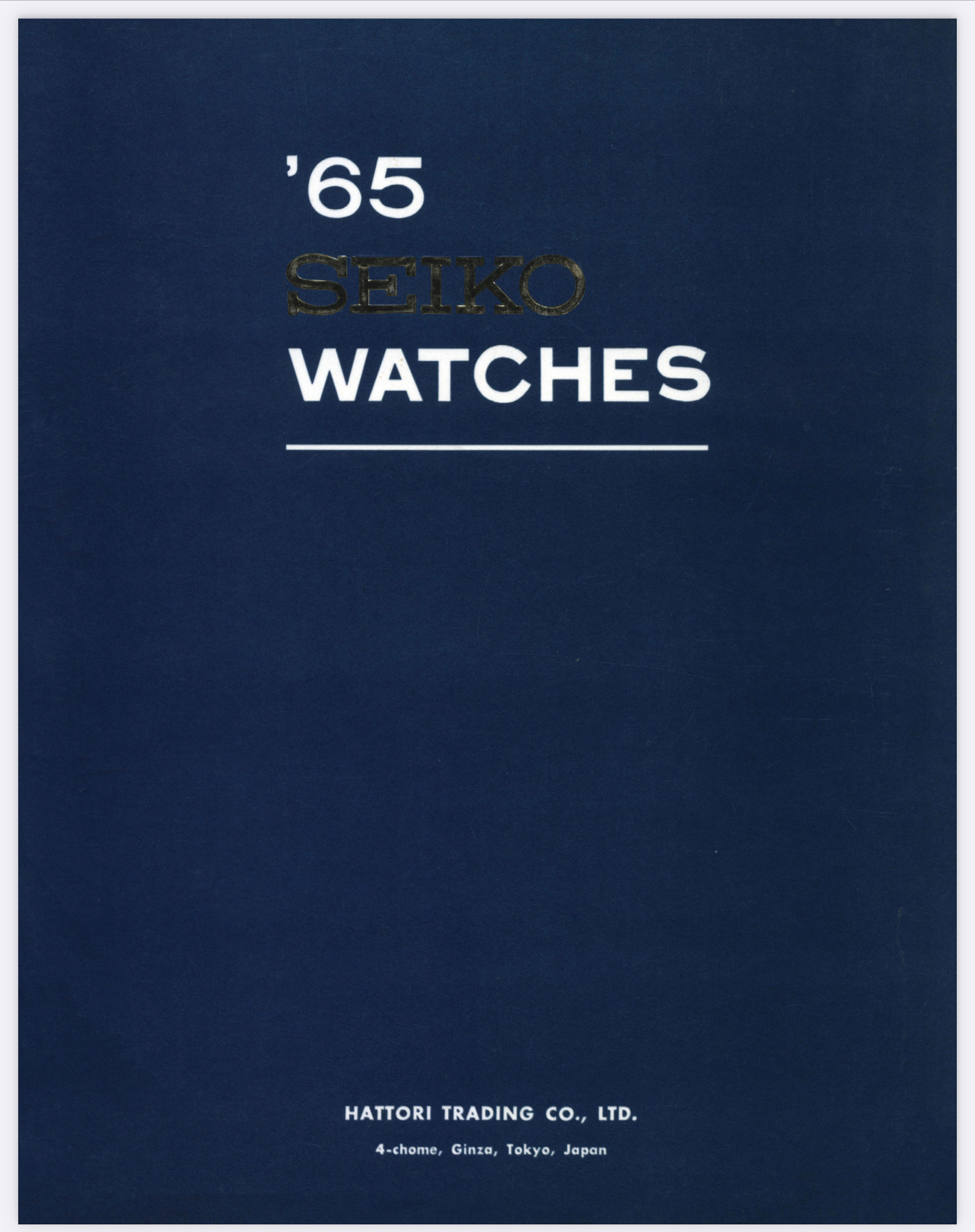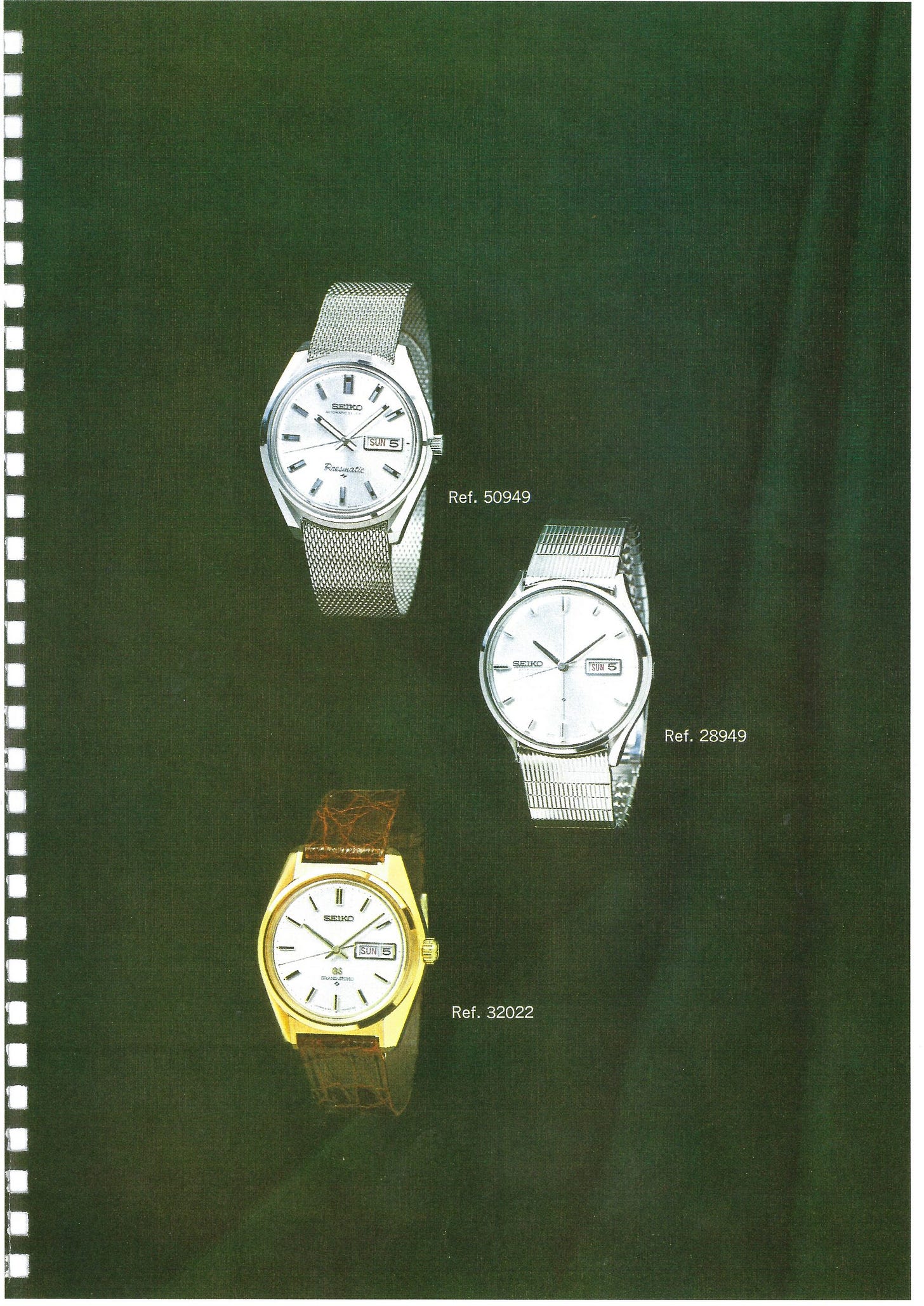Preamble
For the benefit of those subscribers who have signed up recently, I have been publishing a series of newsletters featuring scans of vintage Grand Seikos that appeared in the Seiko Japanese domestic market catalogues of the 1960’s and 1970’s.
The intention behind this series is to cover in detail every single vintage Grand Seiko, with - where possible - corroborating contemporaneous evidence for the legitimacy of the reference.
Following the detailing of all the references that appeared in the Seiko catalogues from 1966 through to 1975, I then covered those references that - for one reason or another - were never featured in those publications.
This final newsletter covers the vintage Grand Seikos that appeared in the Seiko export catalogues.
The Seiko export catalogues
From 1966 onwards, Seiko published a series of catalogues that were distributed to retailers. These catalogues detailed the full range of product on offer, providing a photo of every watch, along with a brief description and salient details including the price, case material, and other basic information.
One of the longest standing mysteries of the vintage Grand Seiko era was whether or not Grand Seiko models were ever made available outside of the Japanese domestic market (“JDM”) that these catalogues served. References such as the 6146-8030 and 6146-8040 make no appearance in any of the JDM catalogues or Seiko Sales newsletters, and interestingly when these references come to market these days, they tend to appear outside Japan.
That mystery was finally solved in 2019 when a 6146-8040 surfaced in London complete with its original papers and sales receipt showing it was originally sold in 1972 in Singapore.
Another intriguing reference would be the 6146-8009 in Cap Gold that was clearly intended for an overseas market, indicated not only by the 9 suffix in the case code, but also by the fact that the caseback makes no mention of the cap gold case, instead describing it as “base metal”.
It was the discovery of the above reference that spurred me - along with Anthony Kable of Plus9Time - to make a visit to the Seiko Museum in Tokyo to see whether or not we could find any evidence of Grand Seikos being sold overseas in the vintage era. Following a request to view export catalogues from the vintage Grand Seiko era, we discovered the existence of Grand Seiko references in three different publications.
Seiko Export Catalogue 1965
The 1965 catalogue was discovered by Anthony subsequent to our visit to the museum, and is the earliest example known to date of an export catalogue to feature a Grand Seiko.
Page 12 of this catalogue shows a 57GS -
From the layout of the dial code text around the 6 o’clock marker, we can identify the precise reference as being the 43999 AD dial variant - a watch that interestingly did not appear in the JDM catalogues, as the earliest of those was in 1966, by which time the 43999 had already been replaced in the range by the 5722-9991.
I am very grateful to Anthony for his allowing me to share these scans of his copy of the catalogue. You can view and download the catalogue in full on his website.
Seiko Export Catalogue 1966
Whereas almost all of the regular JDM catalogues are fully bound, the export catalogues that we were able to view at the museum were comprised of loose-leaf pages in lever-arch binders.
It would appear that Seiko issued new “full” export catalogues every two years, and then provided supplemental inserts as new references were released. This explains why the watches shown on the following scan appear in the 1966 catalogue -
From left to right, the three references featured in this catalogue are the 4420-9000 (early “Diashock” dial variant), the 5722-9991, and the 6246-9000. Respectively, those watches first debuted in the JDM catalogues - 1967 no. 2 supplement catalogue, 1966 no. 1 supplement, and 1968 number 1 catalogue (note – although the 6246-9000 was first detailed in the 1967 no. 2 supplement, it was represented in that catalogue by a photo of the Seikomatic Chronometer).
Clearly a 1966 catalogue would be much too early to feature the 44GS and 62GS shown here, and indeed the page that we found these watches depicted on was in a “supplemental” update to the primary catalogue.
Interestingly, the 6246-9000 is depicted on a unique bracelet that does not appear in any of the JDM catalogues. All three references are listed as being available in stainless steel only, whilst for the domestic market they all were produced with both stainless steel and cap gold cases. Additionally, the 62GS was also produced as the date-only 6245-9000 variant.
Seiko Export Catalogue 1968
For the 1968 catalogue, all three Grand Seiko references that were featured in the earlier catalogue spanning 1966-1967 were dropped, and we see the introduction of the 61GS series.
The watch featured is the 6146-8000 in cap gold, with the early “Grand Seiko” dial variant. This watch made its first appearance in the JDM 1968 number 2 catalogue.
Turning to the next page in the catalogue, we see a different black and white photograph of a 6146-8000, with the reference codes provided for both stainless steel and cap gold variants of the model.
It’s worth noting that this is not the same reference as the 6146-8009 pictured earlier in this newsletter, as that watch has the later “Hi Beat 36000” dial variant without the Grand Seiko text.
The accompanying text beside the black and white photograph indicates that the stainless steel 6146-8000 was also available to order on a bracelet with the code B015S.
Seiko Export Catalogue 1970
The third and final example of a vintage Grand Seiko appearing in an export catalogue that we were able to find was a single photo of the 6146-8000 – this time with the later “Hi Beat 36000” dial variant – on a bracelet.
One can only assume that this is the B015S bracelet mentioned in the earlier 1968 catalogue. Note that the overall design of the bracelet is the same as that depicted on the 6246-9000 in the 1966 catalogue, although with different end-links. As with that found on the 6246-9000, this bracelet does not make any appearance in the JDM catalogues.
And that - finally, is a wrap.
Seiko being Seiko, no doubt in the coming years other reference variants may surface, and possibly other catalogues too. However, as of the time of publication of these newsletters, this is the most comprehensive documentation of the vintage Grand Seiko references that you can find anywhere.
I will be doing one more newsletter related to this series - an “Index” newsletter comprising direct links to each of the published newsletters.
For those with free subscriptions, I will continue to publish articles going forward, the first of which will be coming next week, and will include a full scan of the first issue of Seiko News to feature a Grand Seiko, along with an English translation of the article.
Those with paid subscriptions will of course continue to receive their weekly Friday newsletter detailing “interesting” auctions from current listings on Yahoo Japan.











Every time I revisit the archives the otherwise unknowable to a tyro, is known.